 After two 3-D cookie tutorials in a row, I wanted to make something flat but with some easy added depth and dimension. So I decided to create a simple two-color winter cookie wreath, where the cookies are arranged and displayed in layers. Like my previous fall cookie platter, this wintry one is intended to be shared among friends over (warm!) morning coffee to help cut the chill in the air. Now, you realize, this post probably means I'll do one more (spring) cookie platter to round out my seasonal series, but it will be the last one! [EDITOR'S NOTE: For Manu's summer cookie platter tutorial, click here!]
After two 3-D cookie tutorials in a row, I wanted to make something flat but with some easy added depth and dimension. So I decided to create a simple two-color winter cookie wreath, where the cookies are arranged and displayed in layers. Like my previous fall cookie platter, this wintry one is intended to be shared among friends over (warm!) morning coffee to help cut the chill in the air. Now, you realize, this post probably means I'll do one more (spring) cookie platter to round out my seasonal series, but it will be the last one! [EDITOR'S NOTE: For Manu's summer cookie platter tutorial, click here!]
- Cookie dough of your choice
- Five different tree cookie cutters, or just one if you don’ have a selection (I used this one, which is about 8 cm/3 1/4 in tall, as well as four others whose dimensions can be found in the template attached to the end of this post.)
- Mini (2.5 cm/1 in) tree and leveret* cookie cutters (I used cutters belonging to a mini set from this brand.) *[EDITOR'S NOTE: If you're not familiar with the word "leveret" as I wasn't, click here!]
- Soft round paint brush
- Sugarcraft knife
- Large (about 16 cm/6 1/4 in) round cookie cutter (Or use my attached template, a cake pan, or a bowl for a cutting guide.)
- Medium (about 10 cm/ 4 in) round cookie cutter
- Templates for cutting mountains (Again, see the attachment.)
- White piping-consistency royal icing, in pastry bag fitted with PME #1 tip or equivalent
- White thick flooding-consistency royal icing, in tip-less pastry bag with opening equivalent to PME #2 tip
- Grey thick flooding-consistency royal icing, in tip-less pastry bag with opening equivalent to PME #2 tip
- Pink thick flooding-consistency royal icing in parchment cone with opening equivalent to PME #2 tip (I like to use a parchment cone for very small quantities of icing, as is the case here. See @Julia M. Usher's video to learn how to make one.)
- Liner paint brush for leveret footprints (I used the liner in this Wilton set.)
- Food marker
Step 1: Roll, cut, and bake cookies
a. Roll your dough on parchment paper (or a silicone baking mat) to the thickness you prefer, and cut out five big trees. The group of trees to the left (#1, #2, and #5, pictured below) are about 8 cm/3 1/4 in tall, while the two to the right (#3 and #4) are a little bit shorter, about 7 cm/2 3/4 in and 6.5 cm/2 1/2 in, respectively. This size variation will make the trees to the left seem closer in the final display, and those to the right seem a bit further away.
b. Use one of the larger tree cutters (#1) to cut away part of the left side of tree #2. Likewise, cut away part of the left side of tree #4 using tree cutter #3. Please also refer to the attached template (at the very bottom of this post) for cutting guides for this step.
For the solo large tree in the foreground of the platter (#5), I used a tree cookie cutter with a star on top. However, I didn't want the star on it for this particular design. As shown in the picture below, I used the bottom of the same cookie cutter to trim off the star.
c. Carefully slide large tree cookie #1 next to tree #2 with the cutout. Leave a few millimeters (about 1/4 inch) between them to ensure that they don't fuse together while baking. Repeat the same process with tree #3 and tree #4 with the cutout.
Important: To minimize distortion of the cut pieces, do the entire cutting and sliding process on parchment paper (or a silicone mat). Then place the paper or mat (with cookies) directly onto a cookie sheet, and bake as directed in your recipe. In the event that the dough spreads while baking, the trees in each tree-pair may fuse together. However, the seam between them should be weak, allowing them to easily separate after baking. The advantage of sliding the cookies close together before baking is that the baked cookies will match perfectly along the cutout seam, and each cookie in the pair will have a clean and distinct boundary. Another option would be to make the cutouts in tree cookies #2 and #4 after the cookies have baked but are still warm from the oven. The downside of this approach is that you will cut through the cookie "crust", making it easy for crumbs to get into the icing in upcoming steps.
d. Cut out eight mini (2.5 cm/1 in) trees. (We are going to write the letters of the word “WINTER” on six of them, and use the other two to prop up some of these letter cookies.) If you don’t have mini tree cutters, then cut out eight rounds of roughly the same size. (Below, I cut out one round as an example of the desired scale.)
Note: The minis and large trees have very different baking times, so it's best to bake all of the minis on one tray, and the large trees on a different one.
e. Roll out more dough to your desired thickness. Cut a (16 cm/6 1/4 in) round into the dough. If you don't have a cutter that's big enough for this task, then use the template in the attachments below (or a cake pan or bowl) as a cutting guide, as pictured below. Cut around the template with a sharp sugar craft knife. Again, do this entire rolling and cutting process on parchment paper or a silicone mat, which can be directly transferred to a cookie sheet when it's time to bake the cookie.
f. But first, before we do any baking, cut a smaller (10 cm/4 in) round in the middle of the large round to create a ring.
g. Lift up the round cutter, with the dough still in it, and place it off to the side on parchment paper (or a silicone mat). Using a sharp sugar craft knife and the attached mountain templates, cut the mountains into the smaller circle. To avoid misshaping the small circle, it's best to cut the mountains into it while the cutter is still around it. Carefully remove section #3 of the mountains (it won't be used in the final display), and save the dough for future use.
Next, cut the large ring into four equal parts, along the guidelines shown in the picture below. It will be easier to flood (and eat) the ring if in smaller pieces.
Transfer the parchment paper with the mountain and ring pieces directly to a baking sheet, and bake as directed in your recipe.
h. Once all of the cookies have baked and cooled completely, you're ready to do a test layout! The picture below shows where we're headed. Note: I eventually lopped off one of the mountain peaks (#2), leaving behind just mountain peak #1, as the scene looked too crowded inside the circle with two peaks.
Step 2: Flood trees, mountain, and most of ring
a. Use the chart (in photo a, below) to guide your color choices in Steps 2c and 2d below. "W" refers to white icing, and "G" refers to grey icing. Please note that, in Steps 2c and 2d, you are going to ice only the trees, the mountain, and the three topmost parts of the ring. The bottom part of the ring and leverets will be iced later in Step 3.
b. Using white piping-consistency royal icing and the equivalent of a PME #1 tip, outline all of the large trees (including their trunks), the mountain, and the three topmost ring parts. Do not outline the mini trees. They are really tiny, so it's faster to outline and flood them with the same royal icing - a thick flooding-consistency applied with the equivalent of a PME #2 tip. In fact, you could outline and flood all of the cookies with icing of the same color and consistency, but I prefer to see tiny, sharp white borders on the larger cookies, which is why I outlined them with thicker, white icing.
c. Using thick flooding-consistency royal icing and the equivalent of a PME #2 tip, flood each tree trunk with the "opposite" color indicated on the chart (i.e., if the treetop is supposed to be white, then flood the trunk with grey icing, and vice versa). Then immediately flood each treetop according to the colors on the chart.
d. Now, using the same thick flooding-consistency icing and the equivalent of a PME #2 tip, flood the three ring pieces in grey and the mountain in white. As described in Step 2b, flood six little trees in white and two in grey. For their trunks, pipe a dot at the base of the treetop in the "opposite" color.
Let the icing dry until completely set, about 8 hours.
Step 3: Ice bottom ring section and add footprints; decorate leverets and mini trees
a. Using white piping-consistency royal icing and the equivalent of a PME #1 tip, outline the remaining bottom ring section. Flood it with white thick flooding-consistency icing and the equivalent of a PME # 2 tip. Wait a few minutes for the icing to start to dry. It shouldn’t get crusty; it should just thicken up a bit.
b. Now, let's make leveret footprints in the icing piped in Step 3a. Starting at the top left of the ring section, take a liner paint brush and, keeping it almost parallel to the icing surface, push it into the icing until the paint brush tip hits the cookie underneath. Lift up the brush, and, ta da, you've made your first footprint. Continue in this fashion, adding pairs of footprints along the arc of the ring section.
c. As you can see in the close-up shot below, when the icing is at the right consistency and dryness, the paint brush makes a hole in the icing, but doesn't crack the surrounding icing. The icing also doesn’t stick to the paint brush, and the hole keeps its shape.
d. After letting the icing dry more and crust, hold the paint brush almost perpendicular to the cookie, and gently push its tip into the icing to make a small dent between each pair of footprints. (This step just adds a little more textural interest.) Take care not to push too hard, or you may crack the icing.
e. Onto the leverets! Using pink thick flooding-consistency royal icing and the equivalent of a PME #2 tip, pipe one of the ears, and the body and front paw, on one of the leverets. Let the icing set for a few minutes. (Partial setting of the icing will keep these areas distinct from the remaining areas to be piped in the next step.)
f. Pipe the other ear and an oval for the head with the same pink royal icing.
g. For the tail, pipe a drop of white thick flooding-consistency royal icing on the leveret's bottom. Repeat Steps 3e and 3f with grey and pink royal icing to make a second grey leveret with pink tail. Note: I didn't wait as long between steps for the grey icing to dry, so the head and ears look less distinct than on the pink leveret.
h. One last set of details for the mini trees! Using the same grey thick flooding-consistency icing used in Step 3g and the equivalent of a PME #2 tip, pipe out the word "WINTER" across the six mini white trees.
Let the icing dry completely, again about 8 hours.
Step 4: Decorate trees and ring with snow
a. For snow, pipe dots on the trees, using grey icing on the white treetops and white icing on the grey treetops. Pipe both white and grey dots on the white solo tree that will go in the foreground of the display. Once again, I used thick flooding-consistency icing and the equivalent of a PME #2 tip. I started by randomly piping small dots, from top to bottom; I then added bigger dots randomly in between.
b. Now, move to the upper section of the ring, and decorate it with tiny white dots, keeping them relatively far apart. On the side sections, start at their tops by piping tiny white dots, again relatively far apart. As you move closer to the bottom of those sections, add bigger dots, spaced more closely together. This dot placement will add dimension, ultimately making the top section appear further away than the other two side sections. (For this step, I again used thick flooding-consistency icing and the equivalent of a PME #2 tip.)
Step 5: Add little hut to mountain
a. Use the attached template to gauge the best position for the hut on the mountain cookie, and sketch it with a food marker. A quick sketch will eliminate the risk of ending up with a leaning hut, as happened to me on my first try. (I piped the hut freehand, and no matter how I rotated the cookie inside the ring, neither the hut nor the mountain looked straight. I had to bake and flood again!)
b. Using grey thick flooding-consistency icing and the equivalent of a PME #2 tip, outline and flood the hut that you drew in Step 5a, above. Again, by using the same icing for both the outlining and flooding, the outline on the cookie should merge into the flooding icing, making the outline very difficult (to impossible) to see. After a few minutes, pipe a grey dot on one side of the roof to make the chimney. Let the icing dry until it has crusted on top.
c. Now, using white thick flooding-consistency icing and the equivalent of a PME #2 tip, pipe some snow on the roof, a door, and a dot for a window. Let the icing dry completely.
Step 6: Assemble cookie platter
And now that we have decorated all the cookies . . .
Let’s assemble them and get ready for coffee!
Just follow the footprints to find a surprise behind the tree . . .
Happy holidays,
Manu


Photo and cookie credits: Manuela Pezzopane
Note: Made by Manu is a Cookie Connection blog feature written by Manuela Pezzopane, where each month she shares the method behind a magical cookie of her own making. This article expresses the views of the author, and not necessarily those of this site, its owners, its administrators, or its employees. To read all of Manuela's past Made by Manu tutorials, click here. And to see all of Cookie Connection's tutorials, click here.

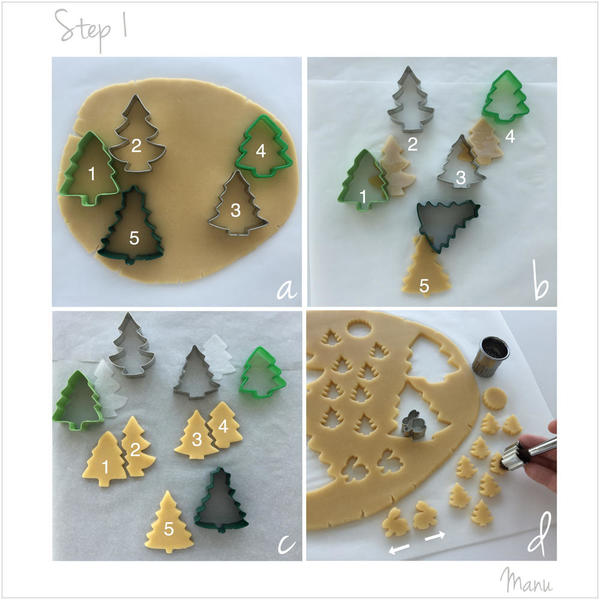
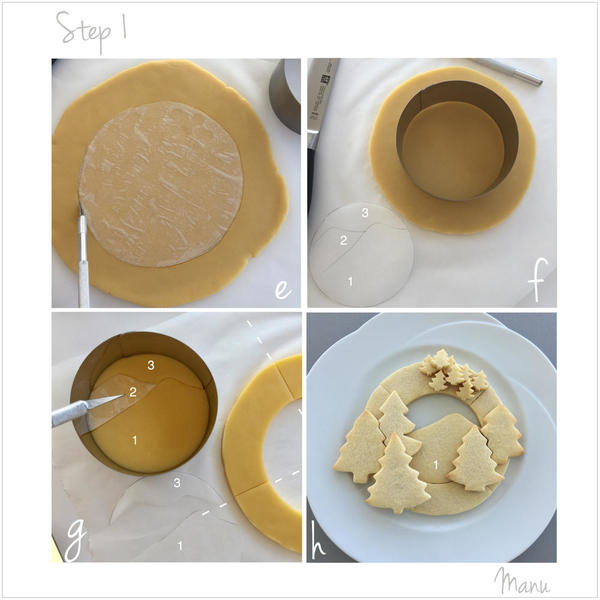
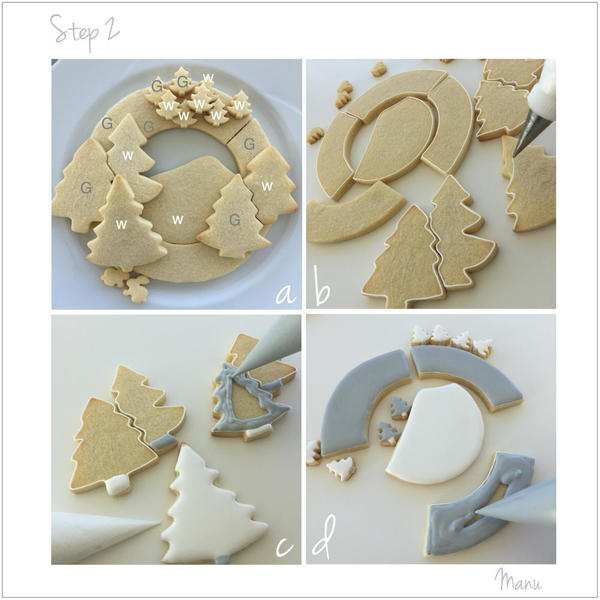
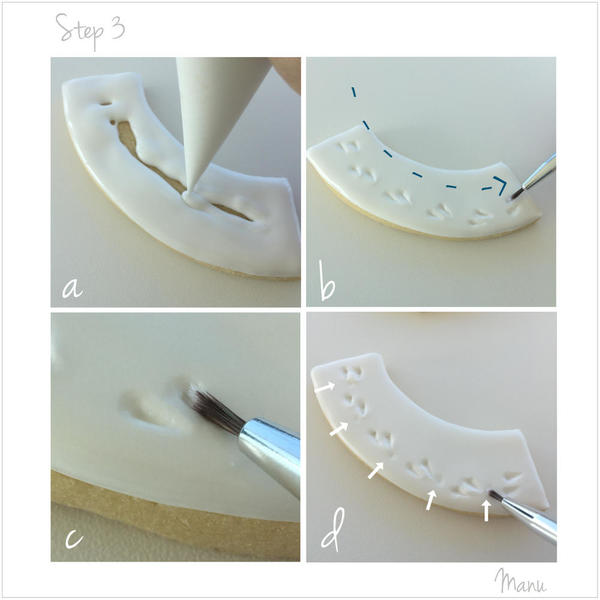

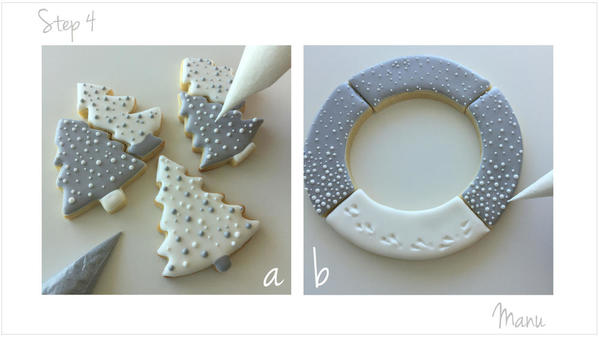

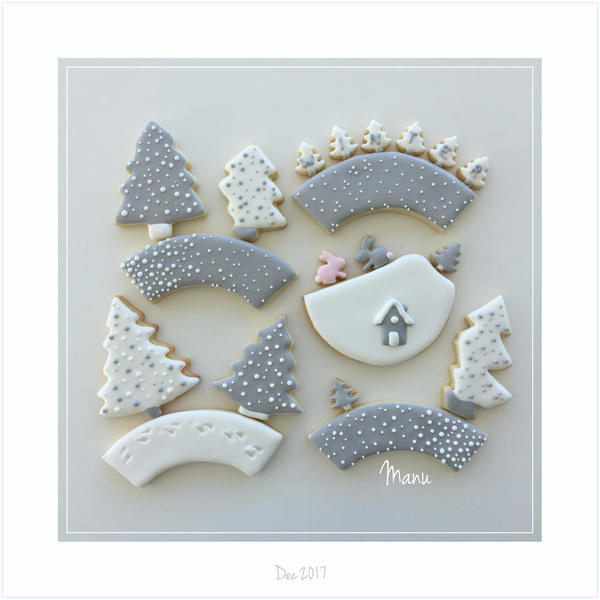
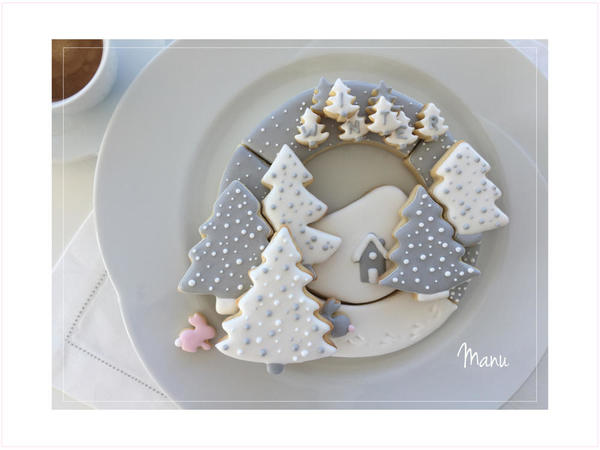
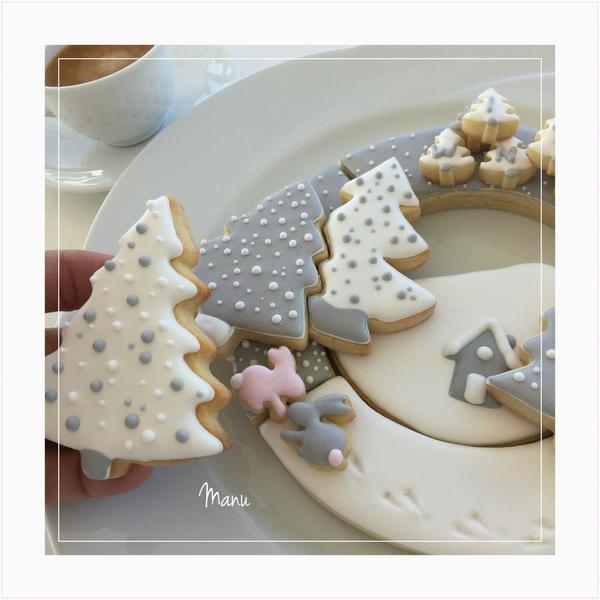
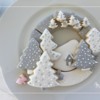




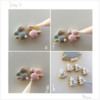





Comments (26)